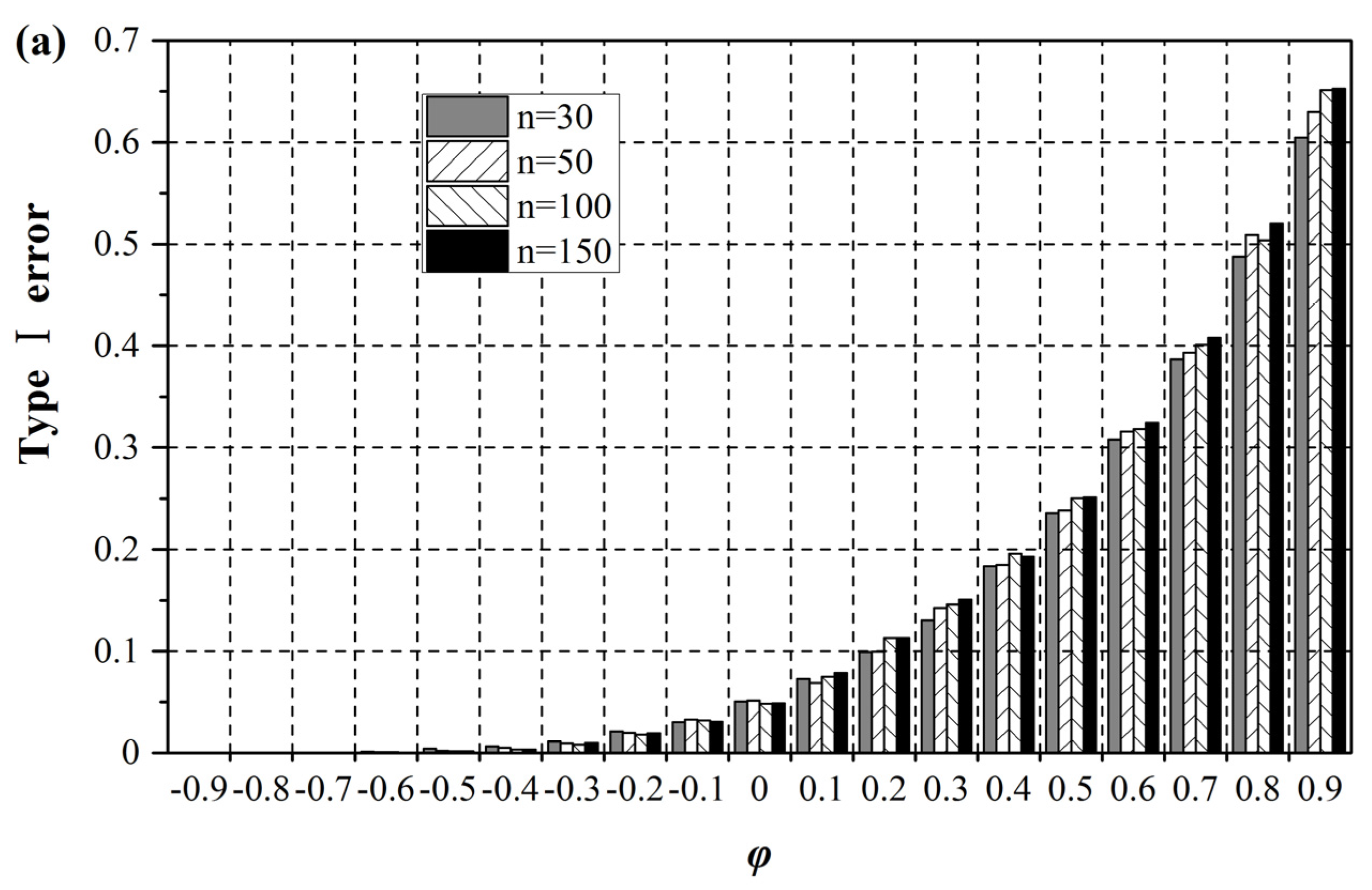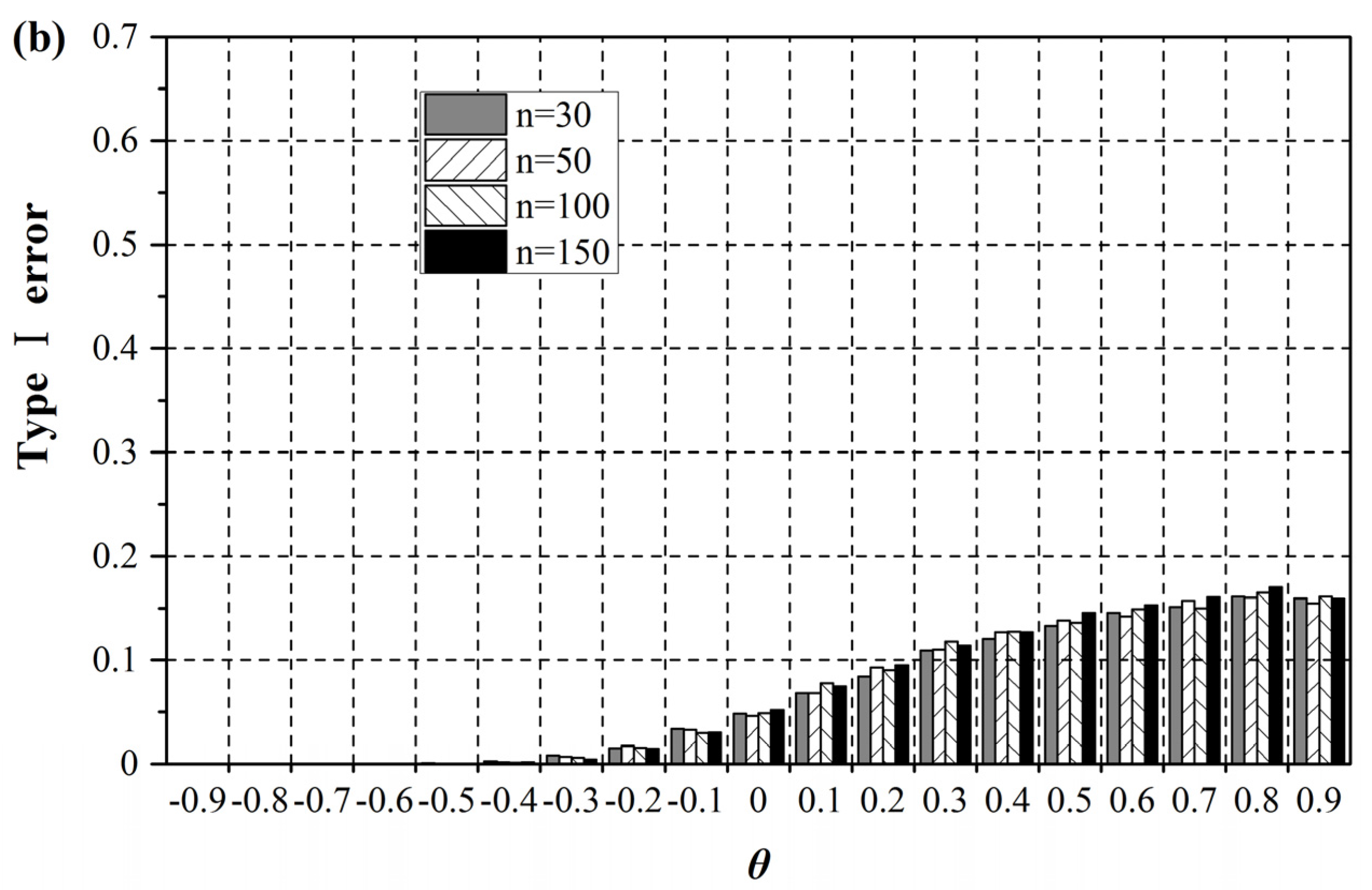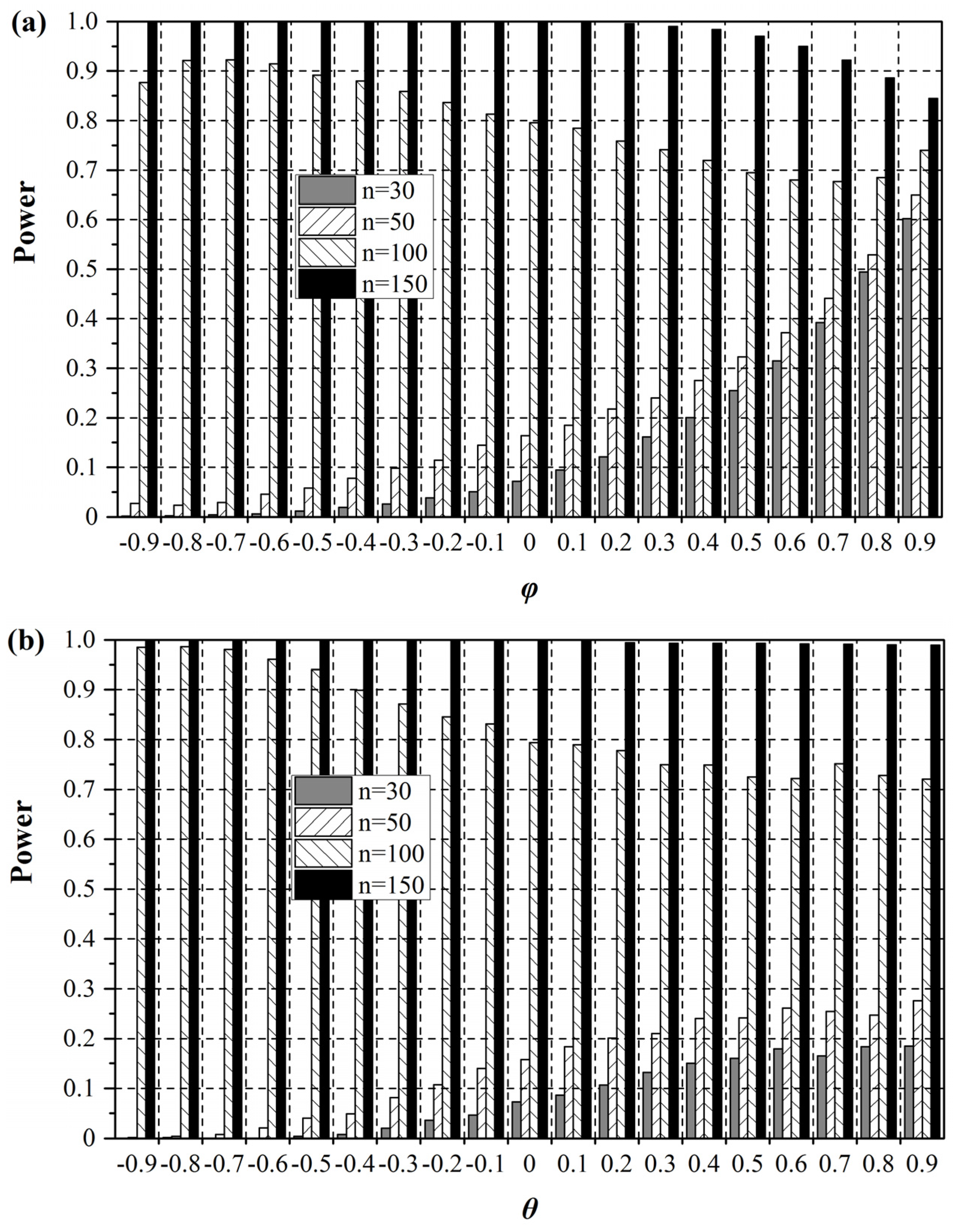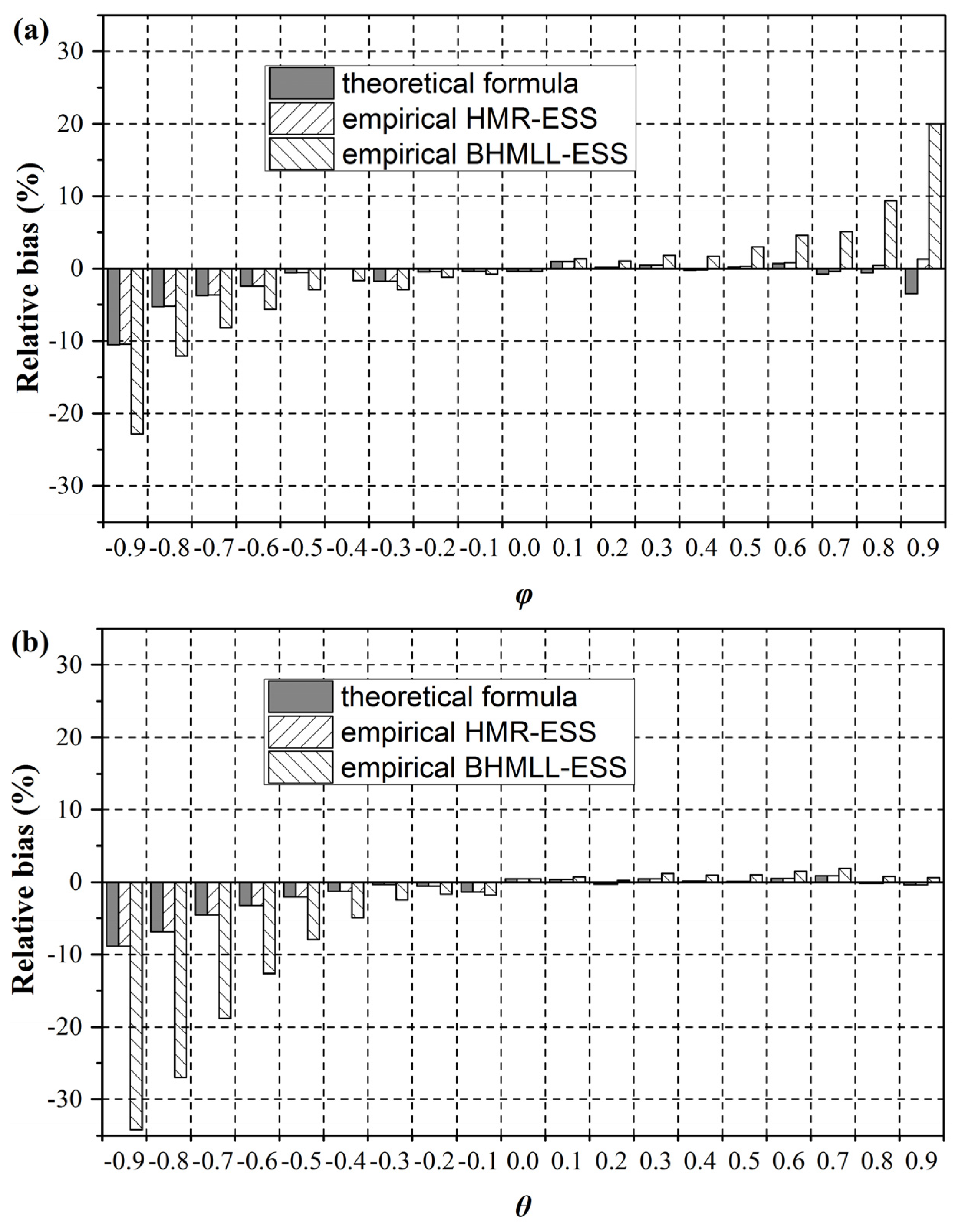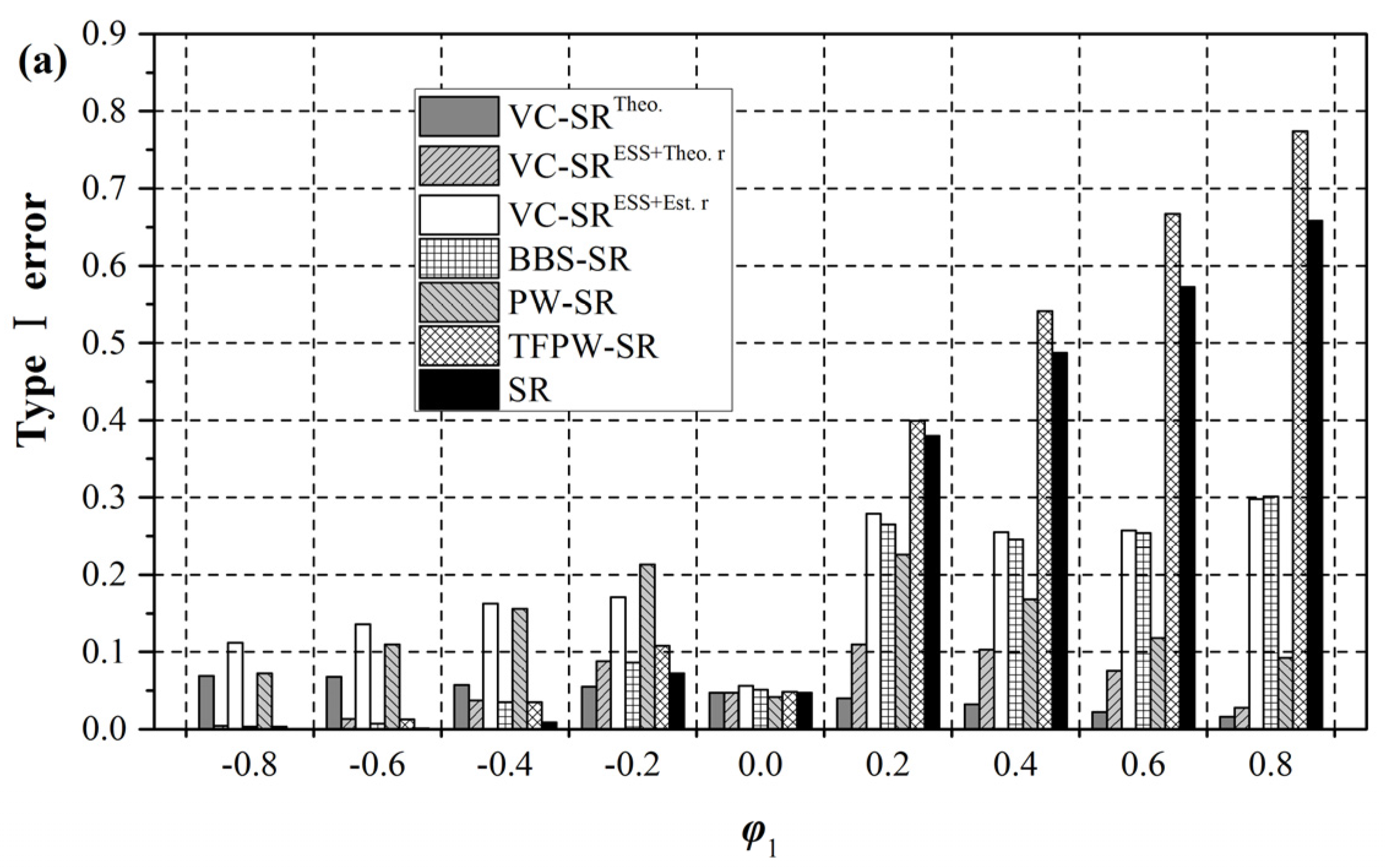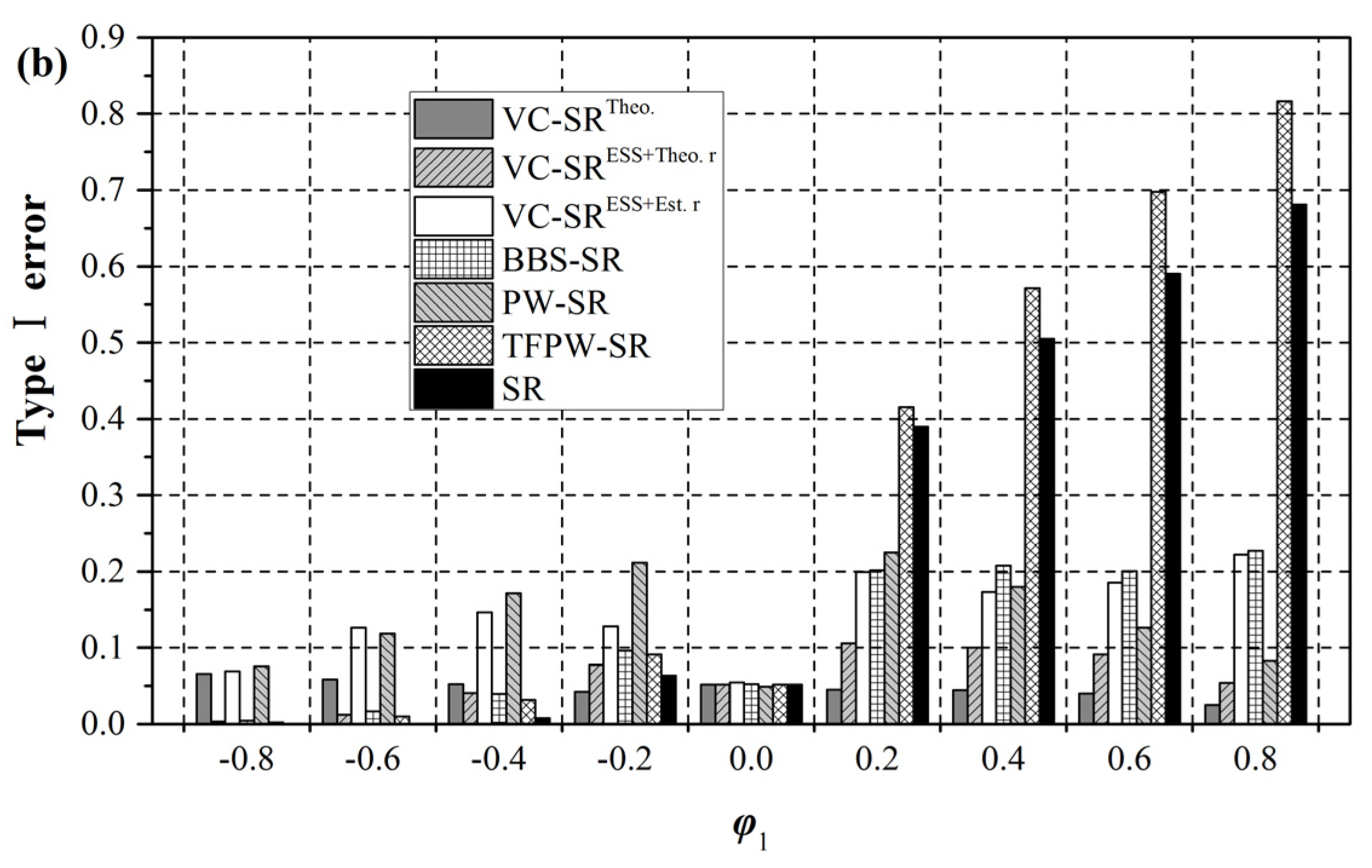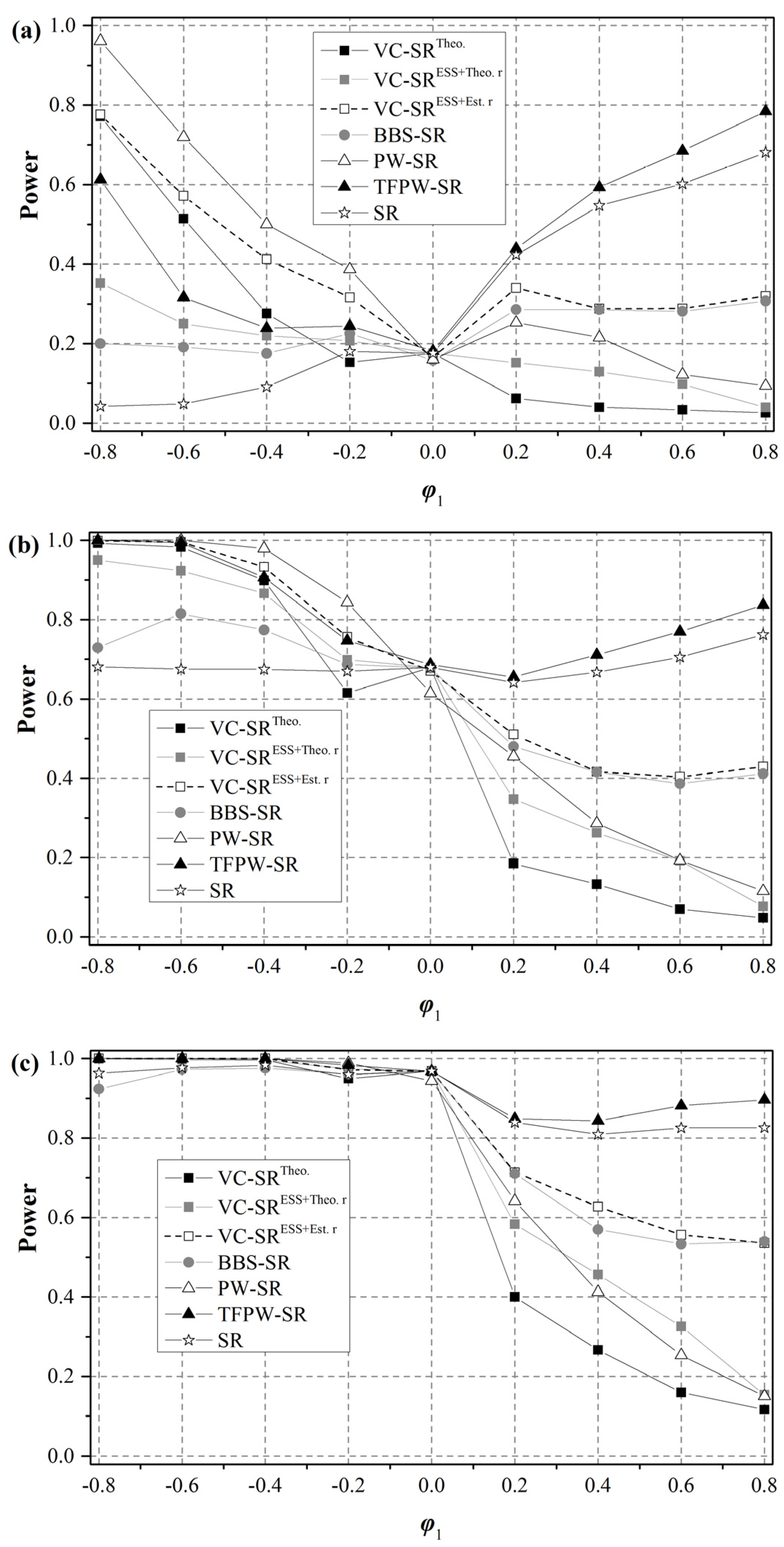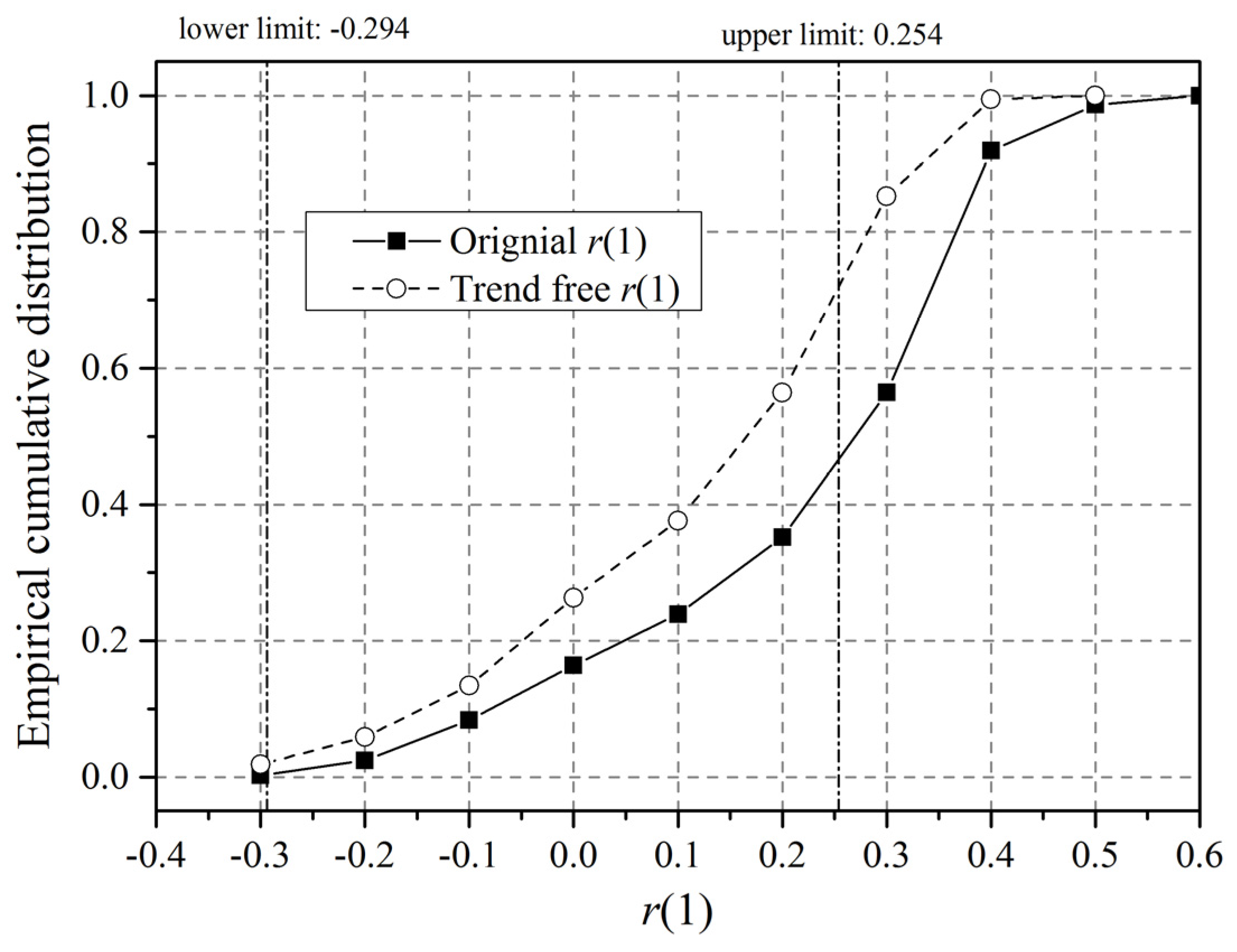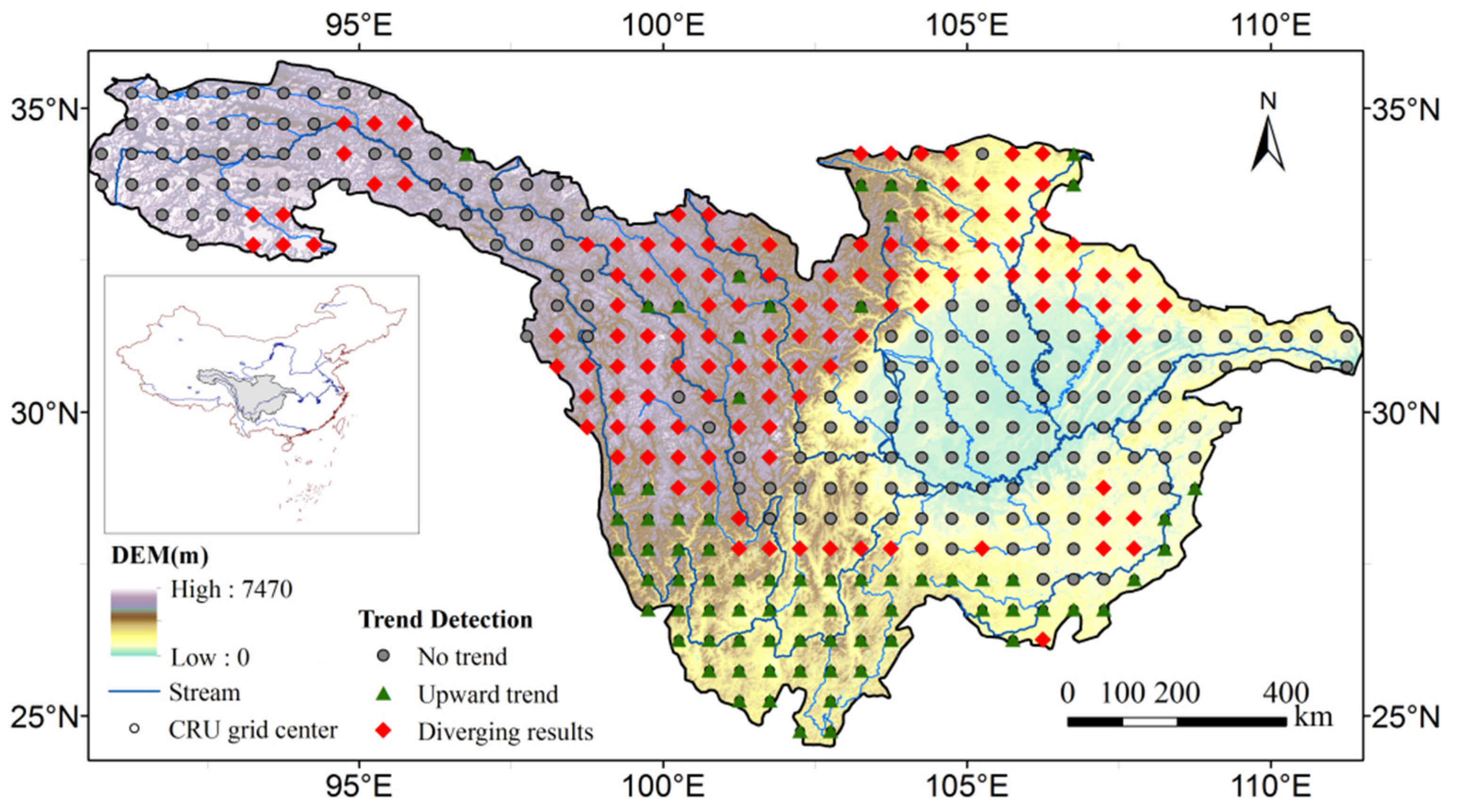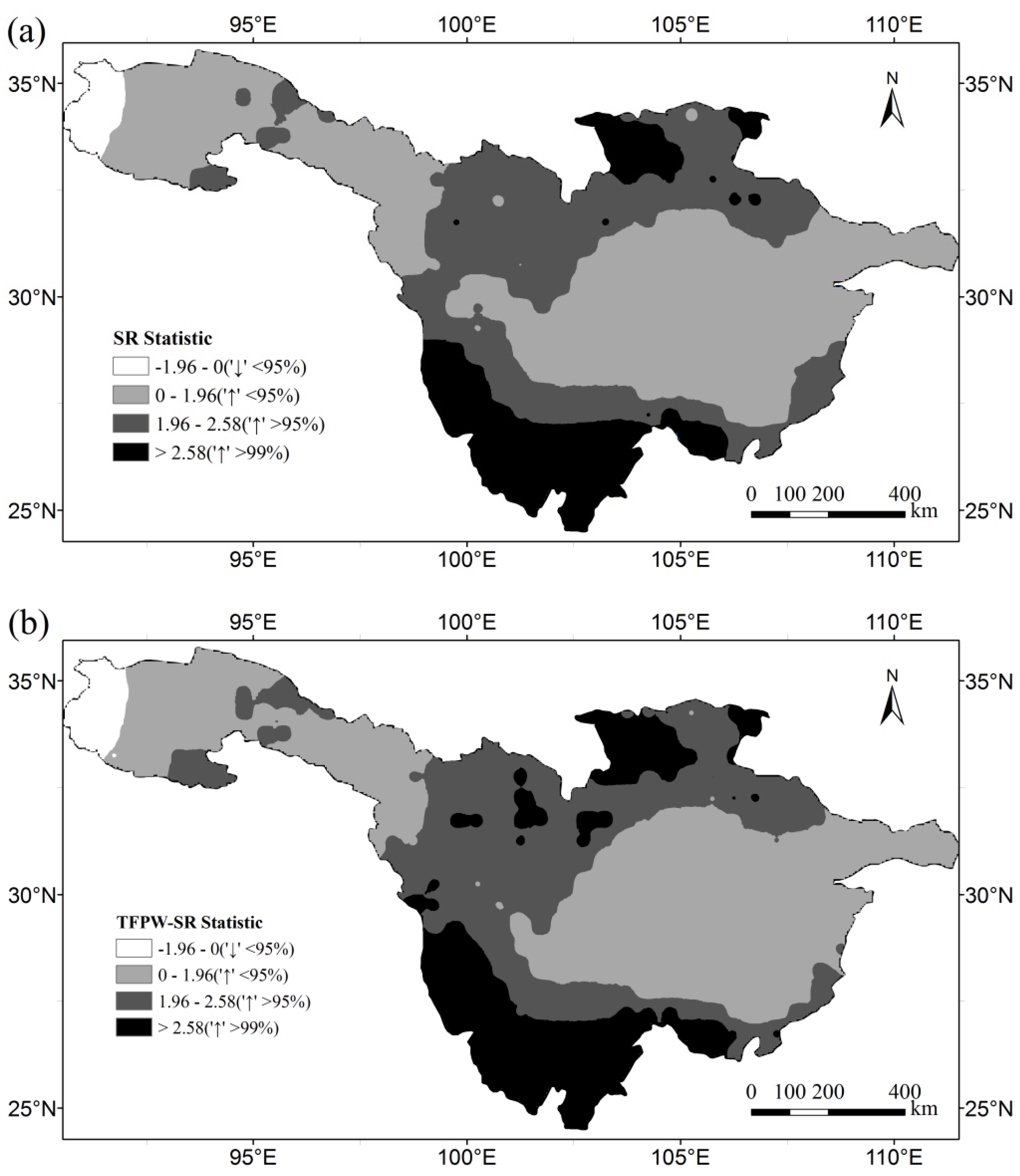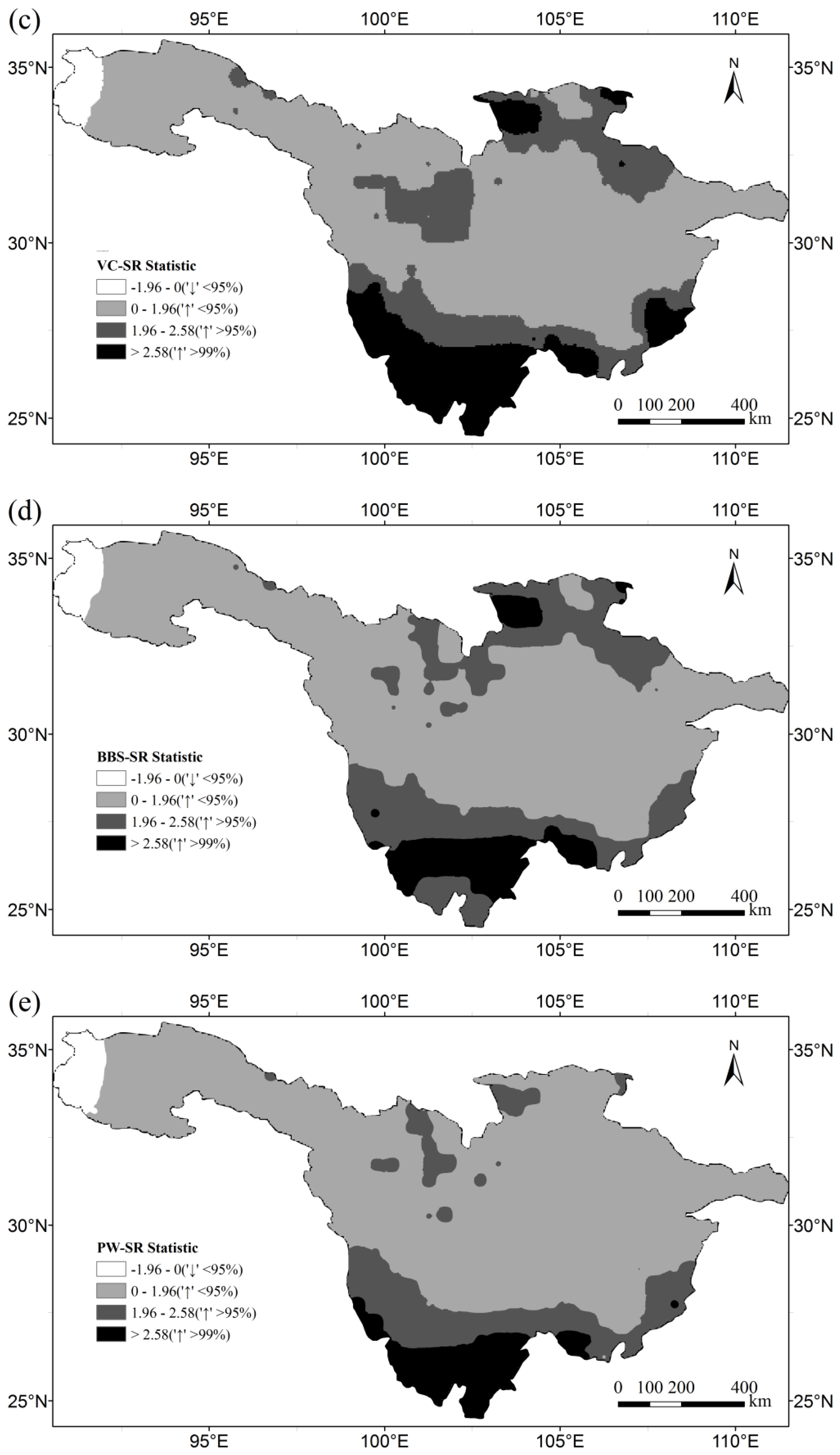1. Introduction
In most cases, statistical analyses of monotonic trends in time series require serially independent data. However, the underlying stochastic processes behind the hydrometeorological time series often contain an autocorrelation component, which can strongly affect the statistical significance of the observed trends. The autocorrelation, also known as “serial dependence”, is ubiquitous in hydrometeorological processes (evaporation, stream flow, temperature, rainfall,
etc.), especially in data series with sub-annual sampling time scales (
i.e., monthly and daily data). Applying a technique that allows for trend detection of serially dependent hydrometeorological series is particularly important when trying to detect weak trends in highly variable time series. Furthermore, trend analyses of serially dependent series often result in an over- or underestimation of the statistical significance of observed trends. This issue was not always sufficiently addressed by studies that are based on the widely used nonparametric rank-based Spearman rho trend test (SR) [
1,
2,
3]. The test is well known for its suitability for data series that have a skew distribution, are censored, or contain missing data. The problem has attracted considerable attention in recent decades, along with an increasing concern related to the impact of intensifying climate change and human activity on the hydrologic cycle [
4,
5,
6,
7,
8,
9,
10,
11,
12].
Several approaches were developed in an attempt to address this problem (Kundzewicz and Robson [
13], Khaliq,
et al. [
14], Sonali and Kumar [
15]). Among these efforts, the most widely accepted and applied approaches are Pre-Whitening (PW), Trend-Free Pre-Whitening (TFPW), Block Bootstrap (BBS) and Variance Correction (VC).
The PW approach, proposed by von Storch [
16], quantifies the autocorrelation component by the lag-one autoregressive model AR(1). Data are pre-whitened by removing the AR(1) component before applying trend tests. This method is without a doubt meaningful if the series can be represented by an AR(1) process; however, the presence of additional trend components will result in this method falsely removing a portion of a true trend and, by that, reducing the power of the trend test [
17]. Moreover, the autocorrelation components are overestimated if the true trend is non-zero. Recognizing these disadvantages, Bayazit and Önöz [
18] suggested that PW is not suitable in the case of large sample sizes and strong trends. Hamed [
19] improved the PW approach by correcting the bias in the estimation of the lag-one autocorrelation coefficient and carefully selecting the autocorrelation model.
To overcome the adverse interaction between a linear trend component and an AR(1) component, Yue,
et al. [
20,
21] introduced the TFPW approach. The basic idea of this approach is to preserve the true slope of linear trends by removing trend components prior to PW before recombining trend components and trend-free pre-whitened series. Rivard and Vigneault [
22] and Blain [
23] suggested that TFPW is suitable for trend detection in negative and positive serially dependent data if slopes of trends are estimated properly. However, recent studies provided empirical and theoretical proof that the TFPW is unsuitable to preserve the correct Type І error, which is the only indicator that can be controlled to prevent a false identification of numerous spurious trends. Some variants of the TFPW approach were proposed to achieve more accurate Type І errors, such as the iterative PW procedure [
24], the TFPWcu procedure [
25], or the Variance Correction Pre-Whitening method (VCPW) [
26].
The BBS approach is based on a subdivision of the time series into several blocks. The data are serially dependent in each block but independent among the blocks. Based on this approach, the blocks can be shuffled several times to generate resampled series. Trends are calculated for each resampled series with the goal of deriving an empirical distribution of the test statistic. Subsequently, the test statistic of the original series is compared to the empirical distribution to evaluate the significance of the observed trend. Önöz and Bayazit [
27] demonstrated that BBS is a robust choice for detecting trends in serially dependent data. It neither inflates Type І errors nor deflates the power of the test excessively. Alternative bootstrapping approaches are phase randomization [
28,
29] and sieve bootstrap [
30]. All of them have the potential to address the influence of autocorrelation effectively.
Another popular approach to deal with this problem is the Variance Correction (VC) method. It is based on the finding that positive or negative autocorrelation components inflate or deflate the variance of the test statistic, even though they might not alter its asymptotic normality [
31]. The VC approach accepts the assumption of serial dependence without prior knowledge of the autocorrelation structure. It is therefore able to handle higher-order dependences than AR(1) [
32]. Hamed [
33] recently derived a theoretical relationship for computing the variance of the SR statistic for serially dependent data which requires considerable computations. In case of
n observations, its calculation requires large numbers of terms which will be of order
n4. The present study aims at deriving an alternative expression for the same purpose with less computational terms,
i.e.,
. Based on that, the new approach would greatly facilitate multisite trend detection studies. In developing this new method, it is obvious that we need to pay close attention to its capability to correct Type І errors and the power of the SR test.
The main goal of this study is to adapt the SR test to serially dependent data via the VC method, an approach which we name Variance Correction Spearman Rho Trend Test (VC-SR). Our study starts with analyzing the effect of autocorrelation on variance, Type І errors, and power of the original SR test. Subsequently, we develop a theoretical formula and suggest an empirical formula as a practical approximation for computing the variance of the SR statistic that takes into account the effect of autocorrelation. Based on simulation studies, we demonstrate that the proposed procedure is effective in mitigating the effect of autocorrelation on both Type І errors and the power of the test. Finally, we apply the proposed procedure to a real world hydrometeorological time series (potential evapotranspiration) to investigate its applicability and discuss its limitations.
4. Simulation Study
4.1. Simulation Design
To investigate Type І errors and the power of the proposed VC-SR test, we generated 10,000 serially dependent series based on two specific forms of autoregressive-moving average models that are characterized by a higher than lag-1 dependence, ARMA(1,1) and AR(2). Their expressions are written by Equations (15) and (16), respectively.
Both of their autocorrelation functions gradually decay in terms of the increasing lags. For the ARMA(1,1) model, the autocorrelation function is given by
The autocorrelation function of the AR(2) model is formulated as
For ease of interpretation of results, we set φ, θ, and φ1 to values ranging from −0.8 to +0.8 simultaneously and simulated series from two models yielding the same values of r(1). As such, the parameter φ2 for the AR(2) model is calculated by . Each of the simulated series has serial standard deviation σx = 0.2 and sample size n = 50,100; β = 0, 0.002, 0.005, 0.008 represent trend free series, series with weak, moderate and steep linear trends, respectively.
Type І errors and Power are calculated by the two-sided rejection ratio, which is given by:
where
is the number of samples that the null hypothesis is rejected by the test. We set the pre-assigned significance level to 0.05.
The use of empirical formulae and unavoidable sampling errors of the r(i) estimation interfere with Type І errors and the power of the VC-SR test. In order to highlight this influence, we discuss simulation results based on three cases. In the first case, we apply the theoretical formula with a pre-known autocorrelation structure. Every lag of data autocorrelation coefficients r(i) is calculated based on the specific autocorrelation function. The test is denoted by VC-SRTheo.. For the second case, we substitute the empirical formula for the theoretical one, and refer to the test as the VC-SRESS+Theo. r test. We also apply the empirical formula for the third case; however, we follow the procedure that only significant r(i) are estimated from the detrended series and the initial r(1) estimator are bias corrected. The test is referred as VC-SRESS+Est. r.
For comparison, we also apply the SR test combined with PW, TFPW, and BBS approaches to each simulated series and investigate their ability to correct Type І errors and power.
4.2. Type І Error Correction
As expected (
Figure 5 and
Figure 6), the VC-SR
Theo. test, to a large extent, restores the inflationary (deflationary) Type І errors to a value close to 0.05. The use of the empirical formula does not change Type І errors considerably. The VC-SR
ESS+Theo. r test yields almost the same results as the VC-SR
Theo. test for the ARMA(1,1) model. It slightly raises Type І errors to around 0.10 in the case of positive autocorrelation for the AR(2) model. Under the influence of sampling errors, the VC-SR
ESS+Est. r test loses some abilities: its Type І errors slightly increase with the increasing autocorrelation. It nevertheless presents a notable effectiveness in mitigating the effect of autocorrelation. For ARMA(1,1) series with small sample sizes (n = 50) and positive autocorrelation, the test reduces the Type І errors of the original SR test from the range (0.15–0.50) to (0.08–0.17). Larger sample sizes (compare n = 100 with n = 50) can further enhance this ability. The BBS-SR test bears some resemblance to the VC-SR
ESS+Est. r test.
Figure 5.
Comparison of Type І errors of different Spearman Rho (SR) tests for ARMA(1,1) series: (a) n = 50; (b) n = 100.
Figure 5.
Comparison of Type І errors of different Spearman Rho (SR) tests for ARMA(1,1) series: (a) n = 50; (b) n = 100.
Figure 6.
Comparison of Type І errors of different SR tests for AR(2) series: (a) n = 50; (b) n = 100.
Figure 6.
Comparison of Type І errors of different SR tests for AR(2) series: (a) n = 50; (b) n = 100.
The PW-SR test, which is AR(1)-based in this case, yields systematic under- and over-rejection for the ARMA(1,1) and AR(2) model, respectively. This problem is mostly related to the model misspecification. Indeed, the ARMA(1,1)- or AR(2)-based PW approach will perfectly preserve stable Type І errors as similar to the VC-SR
Theo. test. Nevertheless, even a slight change in the model structure would interfere with its ideal performance. We take the ARMA(1,1) model as an instance. The AR(1) based approach whitens the series according to the
r(1) estimator of the ARMA(1,1) model. Since parameters φ and θ of the ARMA(1,1) model have been designed to change simultaneously from −0.8 to 0.8 as stated above, we may yield
That means the AR(1)-based approach tends to over-whiten series generated from the ARMA(1,1) model, which can explain the under-rejection behavior depicted in
Figure 5. Detailed results of the influence of the chosen model on the effectiveness of the PW approach can be taken from Hamed [
19].
The TFPW-SR test yields very high Type І errors, which are, in fact, even higher than those of the original SR test. This will result in an unexpectedly high probability of detecting non-existent trends. One reasonable explanation is that the variance of the slope estimator is also inflated by the positive autocorrelation. Even in the case of stationary series, we will falsely report a considerable number of nonzero slopes. To reinstall these spurious trends to the pre-whitened series is obviously detrimental to obtaining correct Type І errors. Another explanation attributes the inflationary Type І errors to the deflationary variance of residuals after whitening the series. By addressing at least one of these reasons we expect to effectively restore Type І errors [
24,
25,
26].
4.3. Power Correction
In terms of power (
Figure 7 and
Figure 8), all SR tests show similar power for independent data (
); however, their performances with serially dependent data differ considerably. The power of the VC-SR test and the PW-SR test decrease with increasing autocorrelation. The TFPW-SR test performs similarly to the original SR test, as their powers fluctuate as the autocorrelation increases. Their power values increase for series with the weak trends but decrease for series with steep trends. The BBS-SR test is almost unaffected by autocorrelation when trends are weak (
).
Given that hydrometeorological series are often positively autocorrelated, the VC-SRTheo., the VC-SRESS+Theo. r and the PW-SR test always rank among all tests with the lowest power. Their ability to detect a real trend will rapidly decrease as the autocorrelation increases. For example, the probability of identifying a significant trend is less than 20% when the slope of the real trend is steep () and the autocorrelation is strong (). Although the TFPW-SR test is the most powerful test, its Type І errors deviate considerably from the pre-assigned significance level, which makes its high power questionable. The powers of the VC-SRESS+Est. r and the BBS-SR test are comparable; their performance is somewhat average when compared to other tests. For series with steep trends, their powers are no less than 50%, even in the case of the strongest autocorrelation.
In light of both Type І errors and power results, we conclude that even though no single test can thoroughly eliminate the effect of autocorrelation, the VC-SRESS+Est. r and the BBS-SR test are practical choices since they are capable of keeping relatively accurate Type І errors without significantly losing power.
Figure 7.
Comparison of the power of different SR tests for ARMA(1,1) series (n = 50): (a) β = 0.002; (b) β = 0.005; (c) β = 0.008.
Figure 7.
Comparison of the power of different SR tests for ARMA(1,1) series (n = 50): (a) β = 0.002; (b) β = 0.005; (c) β = 0.008.
Figure 8.
Comparison of power of different SR tests for AR(2) series (n = 50): (a) β = 0.002; (b) β = 0.005; (c) β = 0.008.
Figure 8.
Comparison of power of different SR tests for AR(2) series (n = 50): (a) β = 0.002; (b) β = 0.005; (c) β = 0.008.
5. Application
We compare the performance of different SR tests based on annual mean potential evapotranspiration records (PET) within the upper Yangtze River basin, which is one of the major water and hydropower sources of China. Continuous annual series from 1961 to 2011 are available at 372 grid points (0.5° spatial resolution) provided by the Climate Research Unit, University of East Anglia (CRU TS 3.22 dataset) [
40]. The analysis of serial dependence reveals that approximately 58% and 28% of grid points yield significantly positive
r(1) values based on the original series and detrended series, respectively (
Figure 9). We therefore expect trend detection results at these grids and statements regarding their spatial distribution to be affected by autocorrelation.
Figure 9.
The empirical cumulative distribution of r(1) values estimated from potential evapotranspiration (PET) data.
Figure 9.
The empirical cumulative distribution of r(1) values estimated from potential evapotranspiration (PET) data.
At the significance level of 0.05, the original SR test suggests that 174 grid points, accounting for 47% of the total grid points, exhibit significant upward trends. However, this number is greatly reduced to 75 (20%) if we require all SR tests to be in agreement. As illustrated in
Figure 10, most of the grid points with positive trends are located in the southern region of the basin. Applying various SR tests yields diverging results for 125 (34%) grid points, most of which are located in the northern part of the basin between 98° E and 108° E. The other 172 (46%) grid points, statistically, have not changed beyond natural variability.
Figure 10.
Trend detection results of annual mean PET data (1961–2011) in the upper Yangtze River basin.
Figure 10.
Trend detection results of annual mean PET data (1961–2011) in the upper Yangtze River basin.
The different power of each test can be verified by observing the spatial distribution of trend detection results (
Figure 11). Clearly, the TFPW approach does not substantially correct the results of the original SR test. In fact, it even overestimates the significance of upward trends in some areas. All other tests mitigate the inflationary significance due to positive autocorrelation more effectively. The PW-SR test rejects the existence of trends for most grid points while the VC-SR
ESS+Est. r and the BBS-SR tests yield similar results. The latter suggests that the northern region of the basin between 103° E and 108° E experienced positive trends.
Figure 11.
Spatial distribution of trend detection results of PET data: (a) the original SR test; (b) the TFPW-SR test; (c) the VC-SRESS+Est. r test; (d) the BBS-SR test; (e) the PW-SR test.
Figure 11.
Spatial distribution of trend detection results of PET data: (a) the original SR test; (b) the TFPW-SR test; (c) the VC-SRESS+Est. r test; (d) the BBS-SR test; (e) the PW-SR test.
6. Limitations
We need to emphasize that applying the proposed procedure of the VC-SR test with confidence requires that autocorrelation is limited to short term persistence (STP). Some case studies demonstrated that accounting for long term persistence (LTP) would decrease the number of significant trends detected under the assumption of STP [
9,
41]. If LTP (including trend-like change) is a possible explanation for natural variability, we may resort to scaling stochastic processes; for example, fractional Gaussian noise model (FGN) or fractionally differenced autoregressive integrated moving average model (FARIMA) to represent the series [
42,
43]. In that case, other parameters, such as the Hurst exponent and the fractional order of differencing, have to be incorporated into the
r(
i) estimators. This will introduce additional sampling errors of estimation. The VC-SR test cannot be readily utilized for long-term persistent data unless these sampling errors are properly dealt with and the normality of the Spearman rho is verified. Based on stochastic simulation results of FGN, Hamed [
33] provided an empirical expression to correct the bias of rho variance due to sampling errors of the Hurst exponent. Furthermore, the exact distribution of Spearman rho converges on the normal distribution in an acceptable manner, although the speed of convergence, in terms of the increasing sample size, is slower than for other trend test statistics, such as Kendall’s tau. Further studies are needed to address Type І errors and the power of the VC-SR test to assess the significance of trends in different scaling stochastic processes and to provide a practical procedure to differentiate LTP from STP.
Another challenge is related to the fact that hydrometeorological variables commonly deviate from normal distributions. The null hypothesis of the original SR test is distributional free, implying that its Type І errors are independent from the data skewness. It is reasonable to infer that the VC-SR test inherits this merit since it does not impose an additional distributional assumption. However, the data skewness does change the power of the test. Yue [
2] found that the MK test is more likely to detect significant trends in variables if they are following Pearson Type III or extreme value distributions rather than normal distributions. If this finding is valid for the VC-SR test, the test would probably achieve higher power than that shown in the current simulation results, which are generated from a normal distribution.
7. Conclusions
Our study addresses the influence of autocorrelation on trend analyses, which is often overlooked in the interpretation of the possible significant trends versus natural random variability. To mitigate this adverse influence, we developed the Variance Correction Spearman Rho Trend Test. It consists of two major efforts. Firstly, we derived a theoretical formula to calculate the rho variance that can account for every lag of data autocorrelation coefficients. Compared with the earlier expression for the same purpose, the new formula can save around 75% of computation time. Both formulae share similar accuracy in calculating rho variance under the influence of autocorrelation for large sample sizes. Secondly, we provide a practical procedure to implement variance correction that only requires significant lags. Statistical simulation results confirm the satisfactory performance of the proposed method. It ultimately yields acceptable Type І errors and maintains a relatively strong power of trend detection. This ability bears much resemblance to the Block Bootstrap method.
Among other techniques, the TFPW approach tends to inflate Type І errors excessively and is not recommended for serially dependent data. The PW approach is more effective for the correction of Type І errors and is still a practical choice for trend detection. Users, however, should notice that its capability is sensitive to model misspecifications if the series are whitened by a parametric autocorrelation model. Furthermore, the PW approach is actually assessing the significance of deflated trend slopes.
We conclude that neglecting the effect of autocorrelation or dealing with it without choosing adequate methods will lead to incorrect results. A first step of a robust trend detection strategy would be an evaluation of regional characteristics of observations. A second step would lead to selecting methods with acceptable Type І errors and power, based on a well-tailored simulation study. A final step would include a comparison of results of various methods and an interpretation of plausible underlying physical mechanisms. The proposed VC-SR test is one meaningful option to implement this strategy.
